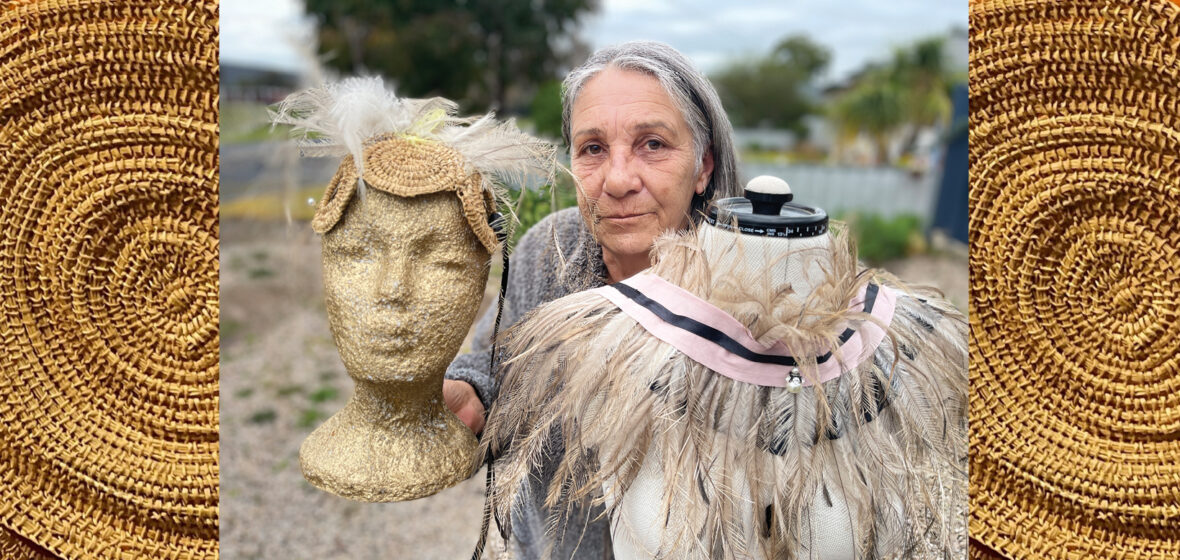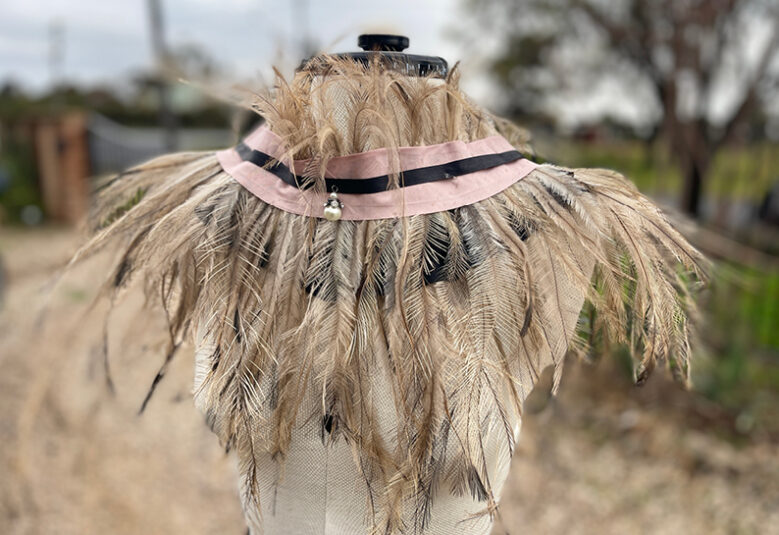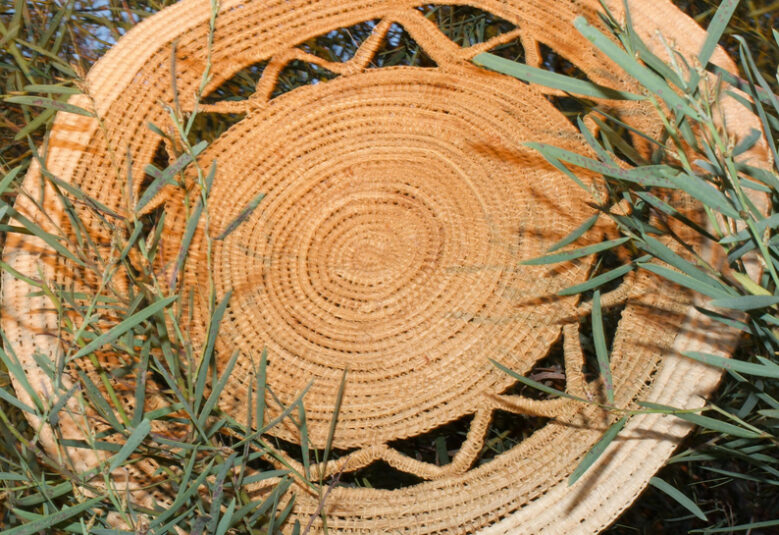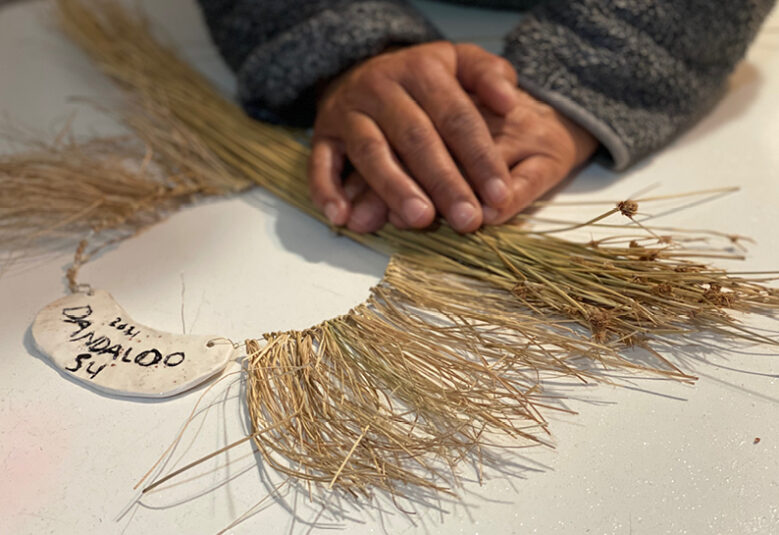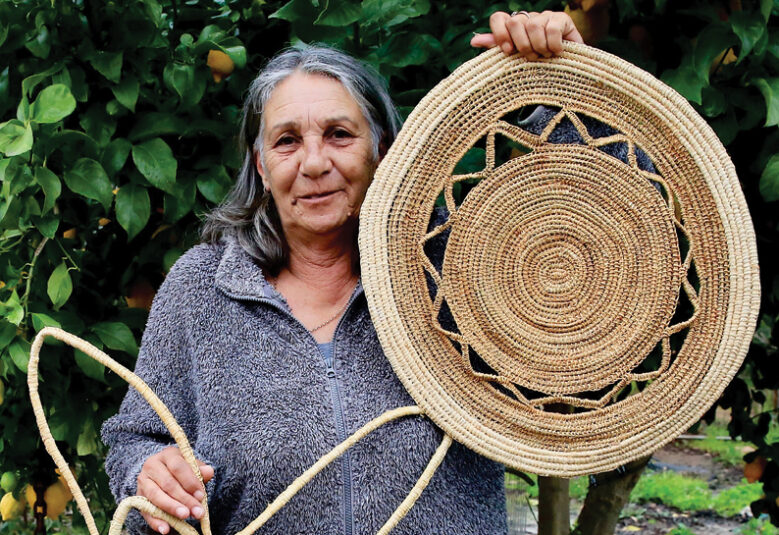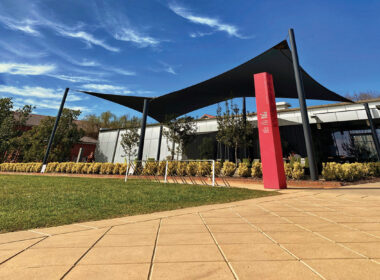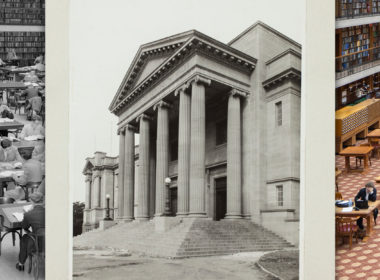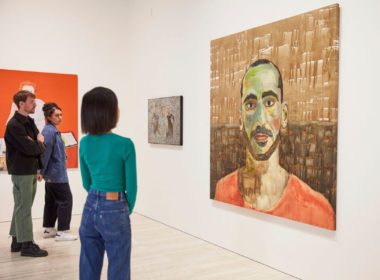We’re at a moment in Australian history when we’re wanting not only to emphasise the importance of Aboriginal culture, but also to shed light on the fact that those practices are still strong and continuing despite the odds.
The art practice of Wellington-based Wiradjuri woman Sue Lousick isn’t just about exquisite weaving – it’s also about storytelling, the passing on of knowledge and the maintenance of traditional ways from the oldest living culture on earth.
PHOTOGRAPHY: STEVE COWLEY
The exquisitely crafted feather neckpiece looks so delicate and fragile that one’s first instinct is to handle it with the lightest of touches, if at all. “Pfft … give it a good feel,” scoffs its creator.
“It’s tougher than it looks. It’s emu feather – you can’t break it.”
Much like Sue Lousick herself, it seems, and certainly a fitting metaphor for the ancient culture from which the artist’s creative works spring. For her art practice, Wellington-based Wiradjuri woman Lousick goes by the name of “DandalooSu”, a nod to her mother’s roots that run deep into the vast plains of western NSW. “Dandaloo is my mother’s country, out on the Bogan River,” the gifted creative says of the land that inspired both her art and her passion for preservation.
Lousick’s art practice involves the time-honoured Indigenous tradition of weaving from native grasses and materials, such as the emu feathers from which the skilfully fashioned neckpiece is made. But it’s not just about the physical product of the practice.
For Lousick, and those she calls the “knowledge holders” from whom she learned the art of weaving, it’s about education. “It isn’t just pretty. It’s about sharing knowledge.”
A source of great motivation for Lousick comes from her years in the community development and environmental management spaces, and the ability to combine her weaving with a conservational message. “I’m telling different stories through my weaving too and hoping that my work also helps encourage others to get in touch with their own traditional cultural practices. I’ve been fortunate to work across a lot of sectors for a lot of years and I found the people who were actively practising their culture and heritage were the happiest, healthiest people I ever met.”
While the weaving, she says, is hard work – “and your hands hurt” – Lousick enjoys the process, including the harvesting of native grasses and materials. But it’s the storytelling element that is her greatest love. “The weaving involves storytelling and the passing on of knowledge – that’s how traditional practices work. It’s a crazy but beautiful process of learning. It’s something that can’t be taught in a classroom. It has to be taught outside, and especially on country. You can learn on other people’s country too, but being outside and in the environment is important,” she explains.
“My culture is adaptive – it’s been adapting for many years. Speaking up about cultural practice hasn’t always been easy, but we’ve adapted and I’ve adapted. My art is liveable – it’s living art.”
Lousick’s coming exhibition, Decolonise, combines both elements of her practice: the weaving and the environmental message, and the art and the education.
“My culture is adaptive – it’s been adapting for many years. Speaking up about cultural practice hasn’t always been easy, but we’ve adapted and I’ve adapted. My art is liveable – it’s living art.”
Lousick’s coming exhibition, Decolonise, combines both elements of her practice: the weaving and the environmental message, and the art and the education.
Western Plains Cultural Centre’s (WPCC) Mariam Abboud, who is curating the show, says Decolonise explores the importance and value of native flora and fauna in the agricultural and fashion industries, drawing on cultural practices of native fibre crafts, knowledge of “gilgais” (small water holes) and three pivotal dates surrounding the introduction of imported fibres into the Australian landscape.
Lousick explains further that the body of work reflects a personal story: “It’s about me and the waterways and where I live and my living art, and about three different points in time: 1788 when the colonists came, then 1817 when they came to Wellington and 1993 when the cotton industry came.”
Abboud believes the exhibition will strike a chord, not just for the beauty of the artworks themselves, but also for the important environmental message they convey. “Sue is a very gifted weaver, and her work is quite powerful,” she says, explaining that cotton and wool are pivotal to the exhibition’s story given the impact these introduced fibres continue to have on the landscape. “To grow and harvest these fibres, farmers drew a lot of water from the gilgais (waterways), which had an impact on the sedge, or native grass, that grew around them and, by extension, on the ability of Aboriginal people to harvest the sedge for weaving.
“So the introduction of cotton and wool impacted not only the landscape, but also the traditional Indigenous art forms and cultural practice.”
Decolonise, according to Abboud, is about reclaiming those traditional weaving practices and bringing back to the forefront those original elements, while using the introduced elements simply as embellishments.
The whole item is made with traditional materials using traditional practice handed down to Lousick through generations, from her grandmother to her mother to herself; it’s the idea of re-empowering Indigenous practice. “Decolonise is a statement about the impact of agricultural practice on traditional Indigenous cultural practice.”
Wool and cotton are here to stay, so they can be additional materials, says Abboud, who offers the notion of a metaphor for Indigenous culture also being here to stay and living alongside but not consumed by introduced culture. “Indigenous culture is the longest living culture on earth, so encouraging this reinvigoration of traditional practice is emphasising the importance of weaving,” she says, echoing the sentiments of the artist herself. “It illustrates that Aboriginal cultural practice is still strong, and that it needs to be maintained, preserved and passed on to the next generations. We should all be learning it, not allowing it to die out.”
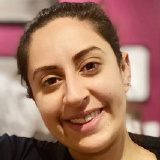 Mariam Abboud Curator Officer at Western Plains Cultural Centre
Mariam Abboud Curator Officer at Western Plains Cultural Centre
That Lousick’s show is exhibiting in the WPCC’s HomeGround gallery space is fitting, given the gallery’s program is about encouraging emerging regional artists. As Curator Officer, Abboud sees a diverse cohort of emerging artists from within the HomeGround’s stated 200km radius; she says Lousick’s works weren’t selected simply for the skill and beauty of the weaving, but also because of the strength of the exhibition’s concept. “We’re at a moment in Australian history when we’re wanting not only to emphasise the importance of Aboriginal culture, but also to highlight that those practices are still strong, and continuing despite the odds.”
There’s also a deeply personal edge to Abboud’s fondness for this particular exhibition, which will open in a community in which 10 per cent of the population is Indigenous. “We want to reflect that relevance,” says the passionate curator of Lebanese heritage who hails from Sydney’s western suburbs. She “grew up in a world, in the nineties, where I didn’t go to galleries and museums because there was nothing spoken about migrant communities”.
“Now, in my role with the WPCC, we try to open up our audiences to as many different and diverse practices and heritages as possible – to open their eyes to linguistically, ethnically and culturally different artists.”
She’s hoping audiences will emerge from viewing Decolonise with a renewed sense of the urgency in the race to preserve heritage, and of the importance of “holding on to culture and tradition”. She adds, “To not allow it to become all homogenised, but to ensure knowledge is transferred to the next generation, not allow it all to become about you in the here and now. Having come from a very strong cultural background, I would hate to see these traditional practices die.”
For Sue Lousick, her hope and message are both simple. “My hope for Decolonise is that it starts people questioning the use of insecticides and thinking about sustainable environmental management. I want to show that the native landscape is beautiful. It’s more than just feather dusters (from emus). Looking after the flora and fauna is important and I want people to look at it and see it as beautiful and something that belongs in everyday fashion.”
Lousick says she’s both pleased and humbled by the opportunity to showcase on such an auspicious stage not only her own work but also, by extension, her culture. “I’m really happy that I can use my cultural heritage to get that message out there, particularly in terms of the use of pesticides and about looking after the environment.”
She adds, “The pieces themselves are beautiful and I hope that the beauty and authenticity of the product helps encourage people to look to their own landscape without importing materials.”
Lousick’s message is powerful and clear: “Be brave. If you think you have something to say, say it. Your art might not say exactly what you want to say, but you can still express yourself. Decolonise – speak up and show there are different ways of doing things. People take away what they want from art – even if they don’t like it. Art is about learning, and Decolonise is beautiful and educational.”
Lousick says she’s “really happy” to be exhibiting in the HomeGround space at the WPCC, and would encourage all Indigenous artists to make a submission to showcase their work. “I think there are people out there who are ready to listen.”

